
Home
Privacy, Terms & Conditions
Occasional Papers
Ancient Mysteries
BOOKSHOP
Epsom and Ewell Waters
Archives/Reviews
Awards Gallery
Destiny
Malvern Waters and Malverns Worldwide
Somerville Diaries
Grotto News
Grotto Essays
Grotto.DirectoryThe Spas OCCASIONAL PAPERS Published by the Spas Research Fellowship
The following papers are either available from this web page or available by post.  Should you make use of these papers you should acknowledge the source including author(s), the Spas Research Fellowship and this web site. The SRF is grateful to Dr Bill Bacon of Cheltenham for refereeing many of these papers and generally advising on their content.
Should you make use of these papers you should acknowledge the source including author(s), the Spas Research Fellowship and this web site. The SRF is grateful to Dr Bill Bacon of Cheltenham for refereeing many of these papers and generally advising on their content.
1. The History of the word SPA and its relationship with water. (click here or scroll down)
2. Heritage and the Spa (click here or scroll down)
3. Health Resorts - defining and marketing (click here or scroll down)
4. New Applications for Spas - drug and alcohol abuse rehabilitation (click here or scroll down)
5. St Chad - Patron Saint of Medicinal Springs (click here or scroll down)
6. Health and Wellness Tourism - past, present and future (click here or scroll down)
7. History of the British Spas Federation (click here or scroll down)
8. Spa Souvenirs (click here or scroll down)
The SRF has access to substantial archive material on spas and mineral waters, including antiquarian and rare books and manuscripts. Searches on-line can be conducted using specific keywords to search our archive facility (click on menu left on "Archives") to give a selected subject bibliography or reading list.
Spas Research Fellowship, Tower House, Tower Road, Tadworth, Surrey. KT20 5QY
For further details contact:
Dr Bruce Osborne, bruce@thespas.co.uk
Spas Research Fellowship, Tower House, Tower Road, Tadworth, Surrey. KT20 5QY
Number 1. The History of the Word SPA and Its Relationship with Water

Without Prejudice Preamble - The provenance of the word SPA has taken on a new significance in the 21st century, particularly English language usage. During the 20th century the word was commandeered by the Spa Monopole organisation of Belgium for a brand name in the bottled water markets. Spa Monopole are major bottlers of SPA water, named after the health resort in the Ardennes where the water is sourced. As a result of a combination of EC Directives, local legislation and legal depositions they argue that they have built up considerable reputation in this word in the water industry but they also claim (and with some success) that if you use this word in other trades, you are infringing their registered trade Mark, SPA.
The counter argument is that the word SPA has a generic application in the English language and has had for many years. In spite of this, Spa Monopole licensed Elizabeth Arden to use the word for a range of beauty therapy products world wide. There is now considerable debate as to whether this agreement has any validity and whether it is reasonable to attempt to commandeer an English language generic word as a brand name for an organisation that does not even have English as its native tongue. If Spa Monopole were ever successful in establishing exclusive rights to the English usage of the word SPA this would have major implications for its use in the health resorts industry world wide. We can see a lot of time and money being spent on arguing this case with the lawyers having a field day while the industry reels from the costs incurred. Perhaps one day we will not be able to use the words "Bath" or "Malvern" either!
Why we call a spa a spa and its relationship with natural waters is something that has been debated extensively. There are two aspects, firstly the evolution of common usage of the word “spa” and secondly, where did the word “spa” originate?
Today we see a spa being defined as a buzzword for health, beauty and relaxation. in Sophie Benge’s book The Tropical Spa (1999). No messing about with 19th century notions of the water cure. In fact the spa is elevated to religious status with worshippers to the altar of self-preservation. This is a 21st century idea of a spa that is revolutionary to the traditionalists, however such a break with tradition does not suit all. In a modern context there remains the belief, based on at least 2500 years of experience, that spas necessarily include water-based therapies. A good description comes from the Harrogate Medical Society in Spa Treatment – for the medical Profession only (c.1920) p.5, which states that "it’s essential feature, and that which distinguishes it from other health regimes, is the administration internally or externally of fresh natural waters at or near their source."
Although spas and their application have developed regional characteristics over the centuries from country to country, the German modern day use of the term gives a useful insight into the broad band of activities that a spa resort can encompass. The following is taken from What is a Spa (2001). 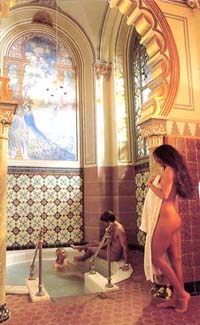
This specific Spa Doctor discipline has arisen from the centuries-old German tradition of Spa and the 20th century establishment of what is known as the German Cure System. This system provides a third leg to the National Health System, that of preventative health care - alongside doctors in general practise and the hospital system. The Cure System, or "The Kur" in German, is based on the widespread acceptance and use of natural therapies and spa therapies and the scientific research that has proven the efficacy of these treatments/cures. This system is used by doctors when their means to treat an individual is exhausted and/or a hospital stay is not yet required for them. In Germany, there are nearly 300 of these beautifully located spa villages and resorts scattered nationwide. Stringent government standards and conditions mean that all are of high quality and the village infrastructure is also of a high standard.
Here we see the German usage and concept of “spa” being used to describe a multifunctional resort. On a world wide basis there is emerging a clear distinction between resorts that offer natural water based therapies and those that offer a more general regime of holistic health care. This distinction is significant for the consumer and the Water for Health scheme and logo enables users of The Spas Directory, the premier search facility for world spas, to determine whether spa waters are available. 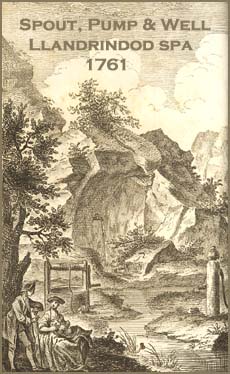
Origins
In Britain the expression “spa” did not come into common usage until the 16th century. Great changes came about in medicine and health care as a result of the policies of Henry VIII. This paved the way for the reintroduction into England of medicinal bathing along classical principals as part of the Renaissance revival of ancient knowledge. As the new industry evolved, an innovation at the end of the 16th century was the drinking of chalybeate springs. This required a new terminology, as the description “bath” was no longer appropriate. Timothy Bright M.D. is attributed with the first use of the name “Spa”, which was coined from the town in the Ardennes where water drinking was a regular practice. We can conclude that at the time there were two types of resort, baths for bathing and spas for drinking. This distinction later became blurred. The first town in England to be called a spa was Harrogate and others like Tunbridge Wells quickly followed. Mary Kershaw of Harrogate Museum takes up the story:
In 1571, one Mr William Slingsby discovered a spring in the then wild moorlands that were Harrogate. He recognised the medicinal properties of these waters from his experience of the wells in Spa(w) in the Ardennes. Mr Slingsby enclosed and paved the well, and recommended its waters to any medical practitioners in the Yorkshire area. These appear to have been the first waters to be taken internally for their medicinal purposes in England, as opposed to the use of springs for bathing. In 1596, Harrogate was dubbed 'The English Spaw' by Dr Timothy Bright, (sometime rector of both Methley and Barwick in Elmet, near Leeds), based on the similarity of the waters to the Continental Spa(w). This appears to be the beginning of the use of the word 'Spa' as a generic description, rather than the place name of the town on the Continent. In 1626, Edmund Deane MD, a physician from York, published 'Spadacrene Anglica', which is the earliest published source for the history of Harrogate's waters, and which promoted their beneficial qualities for medicinal purposes.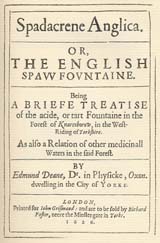
For several centuries in England a spa promoted both internal and external therapies demonstrating the subsequent evolution of the use of the term. Spa type treatments however date back to Greek and Roman times if not before. The Romans built many bathhouses, both public and private and used them for therapeutic purposes. Most Roman settlements had baths and so arguably these were the first spas albeit not known as such. The outstanding ones included Buxton, Bath, Ewell, Castell Collen (Wales) etc. etc. It can also be argued that Celtic Holy Wells performed a spa type function with physical and spiritual healing. Any of the principal ancient Holy Well sites would therefore fall within the broad description of a spa today.
Another body of opinion proposes that the word “spa” itself had even more ancient origins than 16th century Harrogate, when Emperor Nero applied it to the Baths of the ancient Romans. The word SPA it is argued, is an acronym for one or more Latin expressions. The Spas Research Fellowship until recently used “Sanitas Per Aquas” (health through water) on their logo, which comes from Croutier A L Taking the Waters (1992) page 136. The now defunct British Spas Federation, on their web site, said that spa came from “Senare Per Aqua” but give no source for this view. Dr Jeffrey Rosenberg has come up with a third option of “Salus Per Aquam”. This version came from a newspaper article some years ago. A fourth variant comes from the paper published by Thornton and Brutscher What is a Spa? (2001). They state that the root is “Sanus Per Aquam” meaning “health through water”. Judith Lazarus in her book The Spa Source Book (2000) page 165, adds a fifth version to the list with “Solus Per Aqua” meaning “water in itself”. Another suggestion is that it comes from the Latin “spagere” (to scatter, sprinkle or moisten).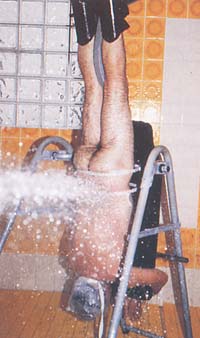
Bea Hopkinson, well known for her researches into Droitwich Brine Spa Water, has added some further information on the expressions above, as follows:
”Sanitas Per Aquas” means "health through waters” (plural) “Senare Per Aqua” means much the same "health through water"(singular) “Salus Per Aquam” may be a scribal error and was meant to read “Sanare Per Aquam”, which is "to heal through water”.
Conclusion
Modern day spas are well-established world wide as places of regeneration and rest, with a holistic approach to mind, body and soul harmony. Places where a person can achieve some form of personal metamorphism. Underlying this approach however spas are also addressing serious medical problems as well as providing leisure and relaxation. The combinations of therapies and experiences are therefore endless and it is apparent that the debate will continue about the subjective issue of what is a spa and where the term originated. It is the 21st century definition a buzzword for health, beauty and relaxation that perhaps gives insights into how spas will be considered in the future, albeit as a two tier market, those with and those without natural waters. For those who insist that natural water is a vital component of any spa, The British International Spa 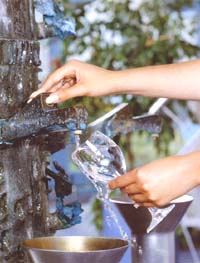 Association, in their newsletter of Spring 2002, defined a spa as “a place where therapeutic treatments are given using healing waters”. At the time this was a workable, broad definition. However since then we have seen a substantial reduction in the application of water in spa therapies and this gives rise to a reconsideration as to whether water should be included in the definition. A suggested modern day definition is proposed as "A Spa is a place that you resort to in order to alleviate lifestyle problems and ailments in a convivial atmosphere."
Association, in their newsletter of Spring 2002, defined a spa as “a place where therapeutic treatments are given using healing waters”. At the time this was a workable, broad definition. However since then we have seen a substantial reduction in the application of water in spa therapies and this gives rise to a reconsideration as to whether water should be included in the definition. A suggested modern day definition is proposed as "A Spa is a place that you resort to in order to alleviate lifestyle problems and ailments in a convivial atmosphere."
The author is grateful to the various contributors and hope that this paper will in turn elicit further scholarship into this matter. The information used in this paper was collated as a result of a number of enquiries on the Internet as well as personal research. The resulting contributions are gratefully acknowledged.
Dr Bruce E Osborne
Spas Research Fellowship June 2002 with subsequent updates.
Number 2.Heritage and the Spa
What is heritage and why is it something that we consider important? Heritage is what we inherit from the past and it is easy to assume that such matters are best discarded in favour of the latest technology and styles. We are all tempted by innovation and fashion, which enables us to do things faster, with lower cost, and in larger quantities. To discard the past however has serious implications. Heritage can take many forms. Cultural heritage is the product of the higher orders of human activity – music, painting and other artistic and creative outputs. The built environment is a heritage and models our landscapes; the countryside is a heritage that brings pleasure to millions. We are surrounded by heritage and the spa resorts particularly have been responsible for making a substantial contribution to the heritage of our nation.
Given this obvious relevance, it is important to consider how we might usefully advance the utilisation of heritage within modern society in a manner that is economically viable as well as intellectually rewarding? Heritage appeals at various levels and each individual will have his own interest level. There are the obvious distinct opportunities to market heritage as a resort attraction and this is well proven. Similarly we often favour areas rich in heritage to live and work. However it is necessary to understand in greater depth our interaction with heritage. This is in order to tune and optimise the role of heritage within our society.
First, heritage provides triggers to nostalgia. Recalling our remembered past is a satisfying pastime albeit probably very boring to the young person obliged to listen. A major appeal of museums and old townscapes is in the trigger to thoughts of the past, to former good times, the good old days. Such recall is inaccurate and biased; was the war really that good? Was the home of our upbringing that much better than today’s modern semi? Selected recall ensures that for us it probably was, at least it likely provided stability and security in a changing world. Also the interpretation of our past is biased by subsequent experience. Distorted memories are a part of our personality and conditioning that we delight in projecting to others as well as contemplating. 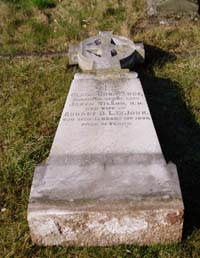
Second, heritage is unique to place. No locality has a heritage identical to any other, and this gives variety. To the tourism marketeer this is a dream come true; the potential to develop a unique proposition that cannot be copied by any other resort. Even if a competitor seeks to copy a heritage artefact, it will always be a copy, never the real thing. This applies to buildings, townscapes, countryside, traditional industries, the arts and countless other aspects of the past that we treasure.
Third, and finally, there is the understanding of our past, our roots. As a result we gain an insight into the human predicament; what we are and how we arrived here. This is a necessary part of our cognitive consciousness, which in turn is one of the prime reasons why humankind has surpassed all other known life forms in our ability to develop. In practical terms, the desire for understanding can range from passing interest through to assiduous study. It can manifest itself in casually sightseeing through to detailed research. Often the participant needs to be first tempted, given a cursory insight that will stimulate further interest. In the extreme it can become obsessive, even providing an incentive for relocating entirely to an area where the heritage appeals.
It may come as a surprise to realise that the progress of man determines that we relentlessly destroy our heritage. Building and countryside must go to pave the way for the new. Old ideas become obsolete and have to be replaced by new. It was in the 19th century that the modern conservation movement first stirred our psyche and artefacts of the past became venerated. The ruthless destruction of an original picturesque medieval Cotswold settlement to make way for Cheltenham Spa was the type of occurrence that solicited the conservation response. Yet today we prize the architecture of Cheltenham. We cannot live in a fossilised world where conservation takes precedence over progress. However by a similar token to destroy all heritage deprives us of the three vital benefits that heritage offers: nostalgia, uniqueness and insight into the human predicament.
There is a balance therefore and compromise. Judgements need to be made and arbiters appointed to make those judgements. Whether it is the planning inspector or the museum curator, someone has to decide on what goes and what stays. As a result we have complex structures within society to handle the debate on social, economic and political levels. In a typical resort such as Harrogate, these range from the elected councillors and officials of the Local Authority, through to organisations such as the Civic Society. These underpin or challenge the policies of Central Government, relayed to a local level through a complexity of Agencies, Departments and law enforcement bodies, not to mention the public voice, expressed through the local papers and other media. We are all participants.
Spas are renowned for their rich heritage: medical, cultural, architectural, social and economic. This author suggests that there are five Rs to consider if heritage is to have a role in the spa resort of the future, either as a backcloth to the underlying proposition and image of the resort or to become the prime visitor invocation in its own right. 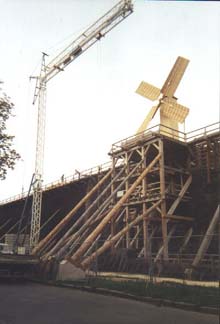
The first of these is “Recognition”. Discover what the resort heritage is, what has survived and how the artefacts might be interpreted. Until you have completed your audit you have no starting point. There is then the second R “Retention”. What is viable and valuable to retain and what inevitably is going to stand in the way of genuine progress and must be lost. This requires a consensus on a broad front and a final conclusion that is supported by all participants. “Restoration” then becomes the issue, what should be restored to former glory, or maintained at the status quo, and at what financial cost? Old buildings have to be used to survive, landscapes need managing, cultural aspects have to be accessed. Do these considerations compromise restoration? Having determined the route through the first 3Rs it is then necessary to take a viability check. Is the route selected the most effective plan to ensure optimisation of whatever Resources are available, be they financial, manpower and expertise or landscape factors.
Only when the first four Rs have been addressed can the final stage be introduced “Regeneration”, not of the heritage in isolation but of the resort in the context of its heritage proposition. This creates a dilemma. The favourable consideration of any heritage often provokes an accentuated public response to preserve all the artefacts regardless. Excessive preservation leads to an absence of modern facilities and economic stagnation can ensue. Alternatively the popularity of the regenerated resort jeopardises the heritage appeal by overwhelming the infrastructure with visitors. The result is destruction of the visitor experience. Such considerations need fine balancing.
Heritage is a remarkable thing. It is not a finite supply. As in the case of Cheltenham cited earlier, we continually create new heritage and in time this matures to become a valued artefact or disappears with progress. The problem and responsibility is in deciding what goes and what stays. After all if we destroy inappropriately our valued heritage, not only do we deprive ourselves of the benefits of nostalgia, uniqueness and understanding the human predicament; we also deprive our future generations of these values and experiences.
The Spas Fellowship Heritage Initiative seeks to resolve these issues through the application of structured investigation. The Initiative resulted from what appeared to be ill conceived disregard for the merits of retaining spa heritage and the subsequent loss of important artifacts and buildings. For details of how the experienced team may be able to assist your hertiage dilemma contact the Fellowship.
Illustrations - Restoration of the Gradierwerk, part of a scheme to retain these listed monuments to a former salt industry, as well as to provide a basis for development of the future health resort - Bad Durrenberg, Germany, Summer 2000. The Art Deco Spa building in Harrogate, built in 1939 to revive Harrogate's spa, the last and greatest of the Art Deco style spa buildings, sadly demolished in 2003 in favour of a residential development. The memorial to Dr Wilson, one of the greatest 19th century spa doctors lies desecrated in Malvern as a result of official vandalism 2004.
Dr Bruce Osborne
Number 3. Health Resorts - defining and marketing
This paper discusses the idea of Health Resorts, with particular emphasis on spas. The use of the term resort suggests that something more than a single facility be under consideration. A resort is seen as a place frequented for a specific purpose, in this instance health. The concept of a Health Resort as an identifiable classification of tourist venue results from the process of destination positioning and market segmentation within the tourism industry. For a tourist industry organisation, market segmentation will play a key role in achieving its corporate goals, by progressing the following three stages:
1. Identification of specific types of market.
2. Development of products to satisfy those markets.
3. Optimum deployment of product and marketing resources to achieve corporate objectives such as employment, health provision, profit (unless a NPO.) etc.; in other words to meet the needs of employees, consumers and investors.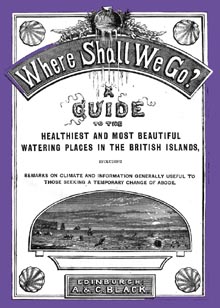
In order to pursue the corporate goals, the marketing strategist will seek to identify and group consumers with similar characteristics within the overall market place, thereby identifying useful sectors for either targeting or ignoring. This process will be conducted using a variety of research techniques. In many industries a trade association on behalf of all member organisations carries out data collection and interpretation more effectively than single operators. The belief underlying the process is that similar consumer characteristics are indicative of similar demand patterns, or more simply put “birds of a feather flock together”.
The strategist will then pursue three stages. Firstly the defining of the tourist or consumer profile that is potentially of interest; secondly the quantifying of the target market and finally the planning of a strategy to penetrate that market. In the case of Health Resorts, the tourist profiles will essentially be one of individuals seeking to either recover from ailments or remain healthy. In order to effectively identify and penetrate a target market it may be necessary to segment the market in greater depth to discover niche opportunities. In the case of the Health Market, which is a very broad description, a further division of that larger sector, for example spa therapies may be appropriate. This niche opportunity can then be quantified to confirm that the forecasted volume and value of that sector will be of a size to justify further exploration. The strategy for penetrating that niche market opportunity will involve the provision of appropriate facilities and infrastructure tailored to compete in that market sector together with the marketing support necessary to promote entry or expand brand share.
Many people seek to define precisely what is a Health Resort or Spa. This runs into endless difficulties because there is no universally accepted categorisation of market sectors within tourism. Also a Health Resort is a very broad term. Instead custom and usage means that individual organisations and companies adopt segmentations that suit their particular purposes. Often the public at large also has a differing view of what is meant by such descriptions as spas, health farms, alternative medicine, thalasso centres, complementary medicine, beauty treatment, sports centres, health clubs, etc., many of which overlap and all of which have a potential role in the Health Resort market. Today we see the increasing adoption of a holistic approach to health incorporating mind, body and spirit. Such a broadening approach includes mainstream and alternative medicine and practices but also can include recreational and leisure pursuits, spiritual welfare, and the living environment. Extending the boundaries further, religion, stress free lifestyle planning and seaside holidays all fall within the remit of a Health Resort. A Spa or Health Resort is therefore a broad ranging concept rather than a precisely definable facility.
Of course a "spa" generally implies therapies involving water and in the modern Spa this invariably means treated rather than natural. As practices change over time it is apparent that definitions are temporal, and this creates further difficulties in defining what we mean by a Spa or Health Resort.
With the broadening of the notion of what constitutes a Health Resort it can be seen that this is a response to consumer needs. As a tourist destination, the concept has a strong relevance in the modern market place but its ever-expanding repertoire of treatments on offer causes confusion. It does represent realistic market segmentation for the tourist industry but its application is at the macro level. Resort planners will function at this level although individual enterprises will seek further segmentation of the market in order to define their target markets or niche opportunities, for example sea water baths.
What type of information will the marketeer seek in order to pursue destination positioning and market segmentation? There are series of reasonably well-defined areas of study appropriate to a tourist destination. The first is segmenting by habit and preferences within the trip. This will include trip booking practices – groups, individuals, “just in time”; seasonality and length of stay; mode of transport to the resort and within the resort; experiences sought; special needs such as invalid facilities and whether a fixed or variable itinerary is anticipated. Frequency of visit to the resort is important because increased frequency is often a more effective route to sales development than to search for new consumers. A new tool for the health resort marketeer is the SRF Spas Directory. This computes the profile of demand from the search criteria determined by the public using the Directory to find a Spa or Health Resort.
The second area of investigation involves the purpose of travel. In the case of Health Resorts this may be for either pleasure or business or a combination of both. In this paper the pursuit of health is a prime reason for travel but as has already been demonstrated this is a macro description, which encompasses a wide variety of sub-sectors. It may also not be the sole purpose of travel. For example a business trip may include a visit to a Spa facility or Turkish Bath. Or a leisure trip may only involve a limited use of a health facility.
The third area of scrutiny is analysis of tourists by demographics. This will be information based on the geographic and personal characteristics of the consumers. It involves amassing information on age, income, sex, marital status, level of education, ethnic origins, family size, religion, etc. It also involves the geographic location of the consumers and this in turn impinges on the first stage above in that length of trip and mode of transport is relevant. More importantly it enables catchment areas for the target consumers to be identified. This in turn aids more effective advertising and promotion.
It is important to consider whether research should be directed at existing users or potential new consumers. The decision to orchestrate market research techniques in such a way as to pick up existing users may well result in a potential new user group being missed or ignored.
The fourth dimension that requires investigation is analysis of psychographics. What are the consumer’s opinions, attitudes, interests and value systems? This will give significant behavioural insight into the nature of the experience that will have to be on offer to attract such tourists. It can also provide information on why the existing product does not appeal and is therefore an aid to new product development as well as marketing communication of the product image and benefits to the potential consumer. Recent trends seek to combine demographics and psychographics into lifestyle classifications for the populace at large.
From the above the marketeer secures a comprehensive vision of not only the tourist needs that existing products fulfil but also where new products and product amendments can be introduced to keep pace with the dynamic nature of the tourist and secure market share. Continual monitoring of the segmentation process enables valuable trend information to be identified and used in formulating strategies. Where a target market is identified the market value can be deduced from a combination of volume throughput and per capita spend.  It may be that both have the potential for increasing the overall share by increasing spending or throughput, both with existing and new tourists. Not only can overall market performance be assessed however, brand share information for competitors can be calculated and the performances monitored over time. This in turn gives valuable guidance to the effectiveness of strategies pursued.
It may be that both have the potential for increasing the overall share by increasing spending or throughput, both with existing and new tourists. Not only can overall market performance be assessed however, brand share information for competitors can be calculated and the performances monitored over time. This in turn gives valuable guidance to the effectiveness of strategies pursued.
In the UK it is very difficult to obtain good quality information in order to provide a basis for destination positioning and market segmentation within the Health Resorts sector. This is due to meagre industry investment in market research, particularly in spas. It is apparent that the market is dividing itself into two distinct opportunities, which dovetail together to give a combined tourist Health Resort profile. Firstly there are people seeking to stay healthy and therefore interested in pursuing healthy activities possibly with an element of restorative therapies. Secondly there are those who have an ailment where they are seeking an alternative or a supplementary treatment to that which is normally available through traditional mainstream medical practice.
The types of ailment that can be addressed at a Health Resort, which positions itself to meet the needs of those seeking to cure an ailment, can be deduced from Continental Spas that continue a long tradition of spa therapies. These include digestive complaints, rheumatism and related problems, skin complaints, gynaecological ailments, artery and circulation disorders, sports rehabilitation, respiratory problems and stress related illness. Potential sources of funding give insights into the demographics and psychographics of consumers. Although National Health funding, or its equivalent, is gradually being withdrawn over time in many countries, it is being replaced with private health insurance, corporate funding under obligations towards employee health and welfare, and personal financing as a result of greater discretionary disposable income.
Those seeking a positive cure harmonise well alongside those seeking a stay healthy experience and successful resorts now address the broader needs of both sectors. This can include a full repertoire of amusement and leisure activities as well as a general resort environment that is sympathetic to the needs of the “stay healthy” tourists. These provide a backcloth to a provision of “stay healthy” facilities, which may include water-based treatments in the case of a Spa, reflecting the holistic approach discussed earlier. The traditional spa and seaside towns are already well equipped since they retain much of their infrastructure and ethos dating back to earlier times. This is not to suggest that the spas of the past should be the model on which to build the future. Modern day aspirations are essentially different to those of the past and much more research and experience is required to be able to be able to determine with confidence how the successful health resort or spa might emerge in the future. Fortunately, ever increasing globalisation does enable the UK to capitalise on experience abroad, both in formulating strategies for the future Health Resorts industry and in expanding the catchment area of potential users.
Further reading: Gee C. Makens J. Choy D. (1997) The Travel Industry, International Thomson Pubs. USA., see Chapter 3.
Dr Bruce Osborne
Number 4. New Applications for Spas - drug and alcohol abuse rehabilitation
Presentation at World Travel Market by Becky Wright, a Specialist Drug worker for the Somerset Partnership NHS and Social Care Trust and a private counsellor specialising in anger and stress management with New Leaf.
I would like to present today a personal perspective of the use of Spa Treatments as a potential tool in the rehabilitation of people with alcohol and drug problems. This research has been published in April 2006 in the Journal of Substance Use.
In Dr Osborne’s prognosis for the future (see paper 6) he touched on the use of water based cures, based on the mineralization of unique water sources, also the expansion of the middle ground between orthodox medical and pampering. The research I would like to present explores further the use of Spas as a source of adjunct treatment for substance misuse and how perhaps the rehabilitation benefits of spas could run along the side of pampering.
Bruce mentioned that perhaps in the future the treatment of alcohol and drug addiction might return to the spas. There is certainly a lack of non-pharmacological options for the treatment of people with substance misuse problems. As a drugs worker we rely heavily upon orthodox medicine at a huge cost to the NHS budget. I have worked as a drugs worker in various establishments for the past 17 years. I have often heard, service users mention their use of steam rooms and home baths to help aid their problem of detoxification and aid relaxation of muscle cramps a common complaint when someone is withdrawing from heroin. These anecdotes prompted this current research, to establish whether spa bathing is currently used for this purpose and whether there is any evidence of its effectiveness. The review was carried out in 2003 and included a literature review together with written and oral responses from individuals and organisations. The review provided an overview of the extent of uses of spa bathing and describes a variety of examples.
The principal research question for this review was, “Have ‘spa treatments’ been considered in the rehabilitation of people with alcohol or drug problems?” For the purpose of this investigation the term, ‘Spa treatment,’ included the use of water or mineralised water as the basis of the treatment for detoxification.
The primary outcomes aimed to identify the use of spa treatments in the rehabilitation of substance mis-users. Further outcomes might include such effects as, pleasurable experiences, which have contributed to relapse prevention and an awareness of and improvement in the person’s sense of self. Bruce mentioned the Social aspects of bathing that is often forgotten.
I had no idea when starting this work that it would end up as a personal journey of discovery.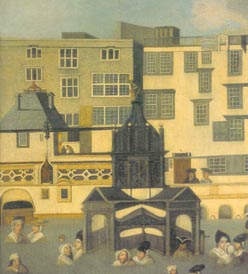 (picture - The Kings bath at Bath)
(picture - The Kings bath at Bath)
As a child my parents would take me to the, ‘King’s Bath,’ (which now lies as a central tourist attraction in Bath, North Somerset). The baths at that time were open to the public for bathing I guess this shows my age!. Bath possesses the only hot springs in Britain, but it is by no means the only spa town. As part of my research I was to visit the Bath Spa Library, where my grandfather Mr Reginald W M Wright, was Director until his retirement in 1954.
As a matter of interest I decided to see if he had conducted any research into the history of the Bath Spas. I found to my surprise his unpublished book entitled, “In and Out of Hot Water.” He had indeed researched extensively much of the history, myths and legends associated with the Bath Waters. This was a wonderful find, uncovering an ancestral interest, of which I had no prior knowledge.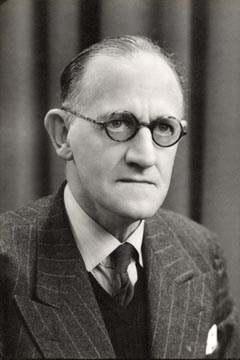 (picture of grandfather)
(picture of grandfather)
Coincidentally the timing of this research has corresponded with the new,’Thermae Bath Spa Project,’ being built with the aim of reconnecting the City with its naturally occurring thermal springs. In some ways this review has also helped reconnect with some of my historical roots.
Method
In terms of the method used, various databases were used to carry out a Literature Search. I also called in the help of experienced literature searchers who completed further searches together with a hand search of books and journals at the Bath Library and Mineral Hospital Library, these mainly showed the historical use of Spas from the early 1800’s to 1900’s.
The many searches did not prove useful in producing the literature required and mainly provided the context and history within which thermal waters had been used some of which Bruce has touched upon. Some of the literature was rejected was not totally relevant because it focussed on for example immersion treatment for people with chronic liver disease, drinking cures by sulphurous water rather than focusing on bathing or steam inhalation for the process of detoxification. Other articles proved too difficult to have translated into English and therefore remained inaccessible. It was decided to therefore start contacting experts within the field of spa medicine, substance misuse and complementary research.
Additional methods used were searching for worldwide organisations that may have funded spa research into substance misuse, writing to Spas which advertised helping people with substance misuse problems, advertising in SPA and associated journals for any unpublished research or anecdotal evidence, contacting UK rehabilitation centres to see if any used Spas as part of their treatment process.
Identifying Experts
In total 18 experts were contacted and two authors of specific books on, “Water Treatment.” This process was by far the most useful. Some responses provided anecdotal evidence of patients using this spa treatment for substance misuse but only two were able to offer a specific reference to written evidence they are namely White B (1998) and Altman N (2000). It was considered that the anecdotal evidence was relevant. I was also able to directly contact spas with the use of The Spa Directory. I also made contact with 21 Drug Rehabilitation Centres in the UK. Each centre was asked if they either used spa treatment as part of their regime or had heard of its use. None of the centres contacted used this form of treatment however, but they were interested in the research outcomes and future possibilities.
Results
From the anecdotal evidence there was little to highlight any robust research into the area of spa treatment with substance misuse. Both White B (1998) and Altman N (2000) provided well-researched books. 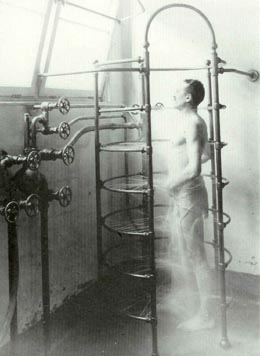 (picture of needle shower)
(picture of needle shower)
White uses the sub heading, “Water and Inebriety,” to discuss the various water cures used in American history. He mentions the flourishing temperance movement and how they had groups who were part of the, ”cold water army.” These men were said to be taking the “water cure.” “Water cure,” in German is Wasserkur it means a hydropathic institution.
The, treatment involved drinking mineral water instead of alcohol. There were also Hydrotherapy Institutions, White (1998) says, “ Water cure institutions caught the attention of many alcoholics during the mid – 19th century,” He goes on to say the institutions served as a place where alcoholics could attend but mask their true condition behind, “ …..such vague labels as ‘neuralgia’ or ‘nervous exhaustion’. He reports that, because water cure institutes required attendees to abstain from popular stimulants like alcohol, tobacco and tea. The facilities were often used as a place for detoxification.
White states, “ The use of hydrotherapy in the treatment of alcoholism can be traced from the mid 19th century water cure establishments to the inebriate asylums, then onto the early 20th century private sanataria and insane asylums.” These treatments included the use of, “ steam baths, hot, cold and neutral baths, needle spray showers; ( show photo of needle spray) hot and cold water sponging; douches; towel rubs; wet packs and frequent water drinking.”
Detoxification
Altman (2000) explores the use of both bathing and drinking thermal and mineral waters as a way of helping ones body to detoxify. He believes this process helps the “body’s natural detoxification by stimulating the liver, the circulatory system and the digestive system, which helps remove toxins from the body”. You will remember Bruce mentioned the Romans using the baths to expel heavy metals by being submerged.
Epstein (1978) carried out extensive studies on the profound effects of immersion on the human body. Later experiments were set up at the Bristol Royal Infirmary to test the hypothesis that during immersion there is an increase in urinary lead excretion. Although lead poisoning is very rare these days the work indicated that immersion therapy in spas could be used as a detoxification process.
Flotation
The flotation tank is usually an enclosed chamber filled with 10 inches of warm saturated solution of Epson salts, this sodium solution is so dense that when a person lies in it they float near the surface of the water. Hutchison
(1984) describes how the experience of floating can be used to aid withdrawal symptoms. He argues that floating reduces the levels of. “ …. Such anxiety – related bio chemicals as norepinephrine , which are released in great quantities during withdrawal.” He states that float tanks are used by many alcoholics and drug addicts to relieve the anxiety and tremors of withdrawal.
Hutchinson states that floating can be used during post-withdrawal state to help addicts not return to their habit. He suggests that during post-withdrawal, addicts are unable to secrete the endorphines needed to experience pleasure and , “..by increasing endorphines, floating enables them to experience pleasure.” It made me wonder if the feeling of being suspended in a warm salt bath is like a replication of early experiences of being cocooned inside the mother’s womb feeling safe and secure. Anecdotal evidence suggests that opiate users describe the physical sensation of taking heroin in similar terms.
Water, Steam & Herbs for drug treatment
Anecdotal evidence came from the Kamkus Clinic in London and the East West Detox Project in Berkshire. These are the only two centres in the UK where it was possible to locate the specific use of water treatments for substance use and addiction problems.
The East West Detox, is a charitable trust, The centre created a new model of treatment that combines both eastern and western philosophies, as well as therapy and medicine. Their holistic programme combines herbal detoxification and rehabilitation and is carried out at the Thamkrabok Monastery in Thailand since 1957. The detoxification process, using a combination of over a hundred herbs and plant extracts, takes only 5 days and is administered as a drink daily. This is complemented by other therapies including herbal steam baths, diet and nutrition with counselling and guidance.”
Mike, a member of the organisation, said he seemed to think that spa treatment in their use of herbal steam treatment was central to their work in Thailand.
The Kamkus Clinic. Has received international recognition for its pioneering work by integrating eastern and western treatment approaches for addictive behaviour problems. The centre can refer someone for hydrotherapy /steam/ ozone therapy.
Ozone therapy can be an ozone sauna, which involves sitting and relaxing in a steam cabinet just surrounding your body and limbs but not your head, while ozone is pumped into the unit so the body is bathed in an ozone-oxygen steam mixture. The steam moistens and warms the skin, opening the pores allowing the ozone to gently penetrate and oxygenate the tissues.
My grandfather Reginald W.M Wright seems to have developed a fascination with the link between the ritual and magical properties of the springs. I discovered in the archives of The Bath Library a large assortment of his unpublished papers and detailed maps showing where he felt Bath should excavate for further springs. He describes the Bath waters as the Cauldron of Regeneration.” Wright, RMW (1959:35) My grandfather speaks of the various Celtic rituals involving casting of , “nine sacred hazels,” into the hot springs to keep them health giving and how its, “divinatory qualities of the hazel generally associated with finding of water and the divining of certain metals.”
The reason why I am quoting this research in my review is not for just sentimental reasons but also a sense of noticing how rituals are often associated with substance misuse. I have often heard users comment on the rituals of injecting or rolling a joint to share with friends. Perhaps the activity of the ritual activates as much pleasure as the drug itself induces? Could the magical and ritual properties of the spas healing properties through the ages be partly why they have attracted people wanting help with their addictions?
So due people with substance misuse problems use Spas? When contacting Spas all respondent’s said that people with drug/alcohol problems may use their facilities, but that this may not be disclosed to them and the addiction could be a secondary reason for their visit. The questions asked evoked responses from centres asking simple questions about the needs of substance mis-users and possibility of Hepatitis infection control risks. There seemed to be a lack of information for spa/ health centres and some misinformation about how to work with this client group, which may explain why patients are not open about their condition. Education around Hepatitis and working with people who have substance misuse problems could allow for these facilities to be further utilised.
The main themes and learning that have evolved from this review include the anecdotal evidence of the use of herbal steam and ozone therapy in current treatment of drug/ alcohol misuse. This includes the current uses of spas to help relax joints and ease pain and the use of floatation as a method of helping with withdrawal symptoms.
I have to acknowledge the lack of robust research into the clinical use of spas for the rehabilitation of people with alcohol or drug problems.
The process of contacting Spa Centres uncovered a lack of knowledge on working with people with substance misuse problems including fears on infection control issues.
Historical evidence was uncovered in America from Spas being used in the treatment of alcoholism. Together with historical anecdotal evidence of rituals and magic associated with Bath Spa.
Perhaps the most powerful impact of this research was the personal journey of learning new skills and discovering old historical roots previously unknown to me.
The literature review set out to identify, ‘spa treatments,’ which have been considered for the rehabilitation of people with alcohol or drug problems. The information obtained has shown that Spas do have a historical connection with the treatment of substance misuse. This includes the use of steam, drinking mineralised water, bathing in hot waters, floating in epsom salts, ozone sauna, hot cold and neutral baths, needle spray showers, hot and cold water sponging, douches, towel rubs and wet packs. It can only be hypothesised as to why the research was unable to locate any clinical research literature relevant to the subject. Instead it has relied on individuals personal experiences, historic text, expert testimonies and transpersonal insights and theories.
Spas are used world-wide to help alleviate a range of health problems, and ‘taking the waters’ has been valued for centuries here in the UK as part of a cleansing and detoxifying process. Water is used in two ways internally since the early 19th Century in specific relation to substance misuse and secondly water remains a component of some external regimes in the 21st Century but the evidence as to the effectiveness of these is for most part anecdotal.
Authors who write on the subject of spas and water treatment mention the properties of using spas to both detox the body and aid in the process of anxiety and tremors within withdrawal and relapse prevention. The use of floatation was cited as a treatment that provided pleasure by reducing the amounts of noradrenaline present. The process of floating was said to increase endorphins and therefore experience pleasure that previously the drug may have given the user.
It could be acknowledged lack of knowledge and pre-judgement around the issue of substance misuse and infection control may be preventing the spa health centres taking an interest in working directly with this client group. Further research could be initiated to discover what the specific learning gaps are possibly preventing clients accessing their services.
The historical evidence provided by White W (1998) suggests that Spas were a place where people who had addiction problems could detox and rehabilitate perhaps by using other conditions like neuralgia and nervous exhaustion to disguise their true problem. Where as Altman N (2000) writes about the use of spas to help neutralise the ill effects of certain drugs and stimulate liver detoxification. Perhaps in the future a substance user would be able to obtain a specifically chosen combination of salts from the treatment agencies to place in the bath to replicate therefore replicating the process obtained in spa centres.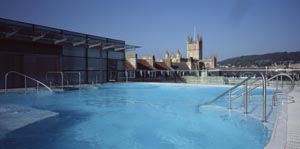 (picture of Bath Spa today)
(picture of Bath Spa today)
In 1976 the Bath council closed the spa treatment centre which then altered Bath’s role as a spa resort. It is hoped that the new opening of the, ’Thermae Bath Spa Project’, could regenerate interest in spa treatment and provide a much needed research/treatment facility. Paradoxically the concept and acceptability of spas being used as detox for beauty is widely accepted, however to detox for the purpose of substance misuse seems less socially acceptable or fashionable. If effective, spa treatment could offer local substance mis-users with an opportunity to experience a drug free treatment which is person centred, non-pharmacological and adjunct to current treatment options.
Becky Wright 2006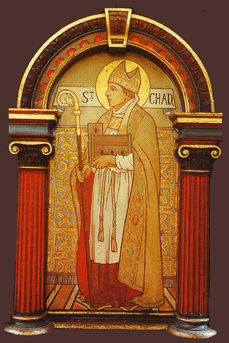
Number 5. St Chad - Patron Saint of Medicinal Springs
Dr Bruce Osborne - revised Spring 2009
The Archaeological record
There are a number of significant sites in England that celebrate the cult of St Chad. This interesting phenomenon first identified by James Rattue in Living Stream, (1995) is the preponderance of St Chads Wells. This list has subsequently been consolidated by Harte (2008). The value of Harte’s work as an authoritative publication is that it provides a gazetteer of sources and their recording over the centuries and as such is a new prime reference point for anyone wishing to locate and conduct further research on particular sites or cults. The bibliography in particular gives students of Holy Wells a substantial guide with regard to source material. Harte identifies the following early spring/well sites dedicated to St Chad in addition to Lichfield Cathedral itself.
In the examples the locations are given with an indication of the date of known first recording. Tushingham in Cheshire 1301 (p.27); Lastingham in Yorkshire 19th century (p43, v2p356); Stowe near Lichfield 14th century (p44,101, v2p325); Abbots Bromley in Staffordshire c.1300 (p.64, v2p321); Wilne in Derbyshire medieval (p64. v2p190); Chadkirk in Cheshire c.1306 (p64, v2p178); Chadshunt in Warwickshire 1695 (p64,79, v2p331); St Pancras in London (p.64, v2p266); Bedhampton in Hampshire (v3p443); Stepney in London (v3p448). Chadwell in Essex 19th century (v3p388); Chadwell Heath in Essex 19th century (v3p388); Birdbrook in Essex 19th century (v3p388); Brettenham in Norfolk 19th century (v3p402); Peterborough in Northamptonshire 17th century (v3p403); Warmington in Northamptonshire 20th century (v3p404); Chadswell in Shropshire 19th century (v3p407); Midsomer Norton in Somerset 19th century (v3p413); Chaigley in Lancashire 20th century (v3p430); together with a number of doubtful and spurious wells as follows: Pertenhall in Bedfordshire (v3p436); Shodwell in Cheshire (v3p437); Prestbury in Gloucestershire 1201 (v3p442); Twyning in Gloucestershire (v3p443); Ware in Hertfordshire (v3p444); Chaigley in Lancashire (v3p446); Barton-upon-Humber in Lincolnshire (v3p447); South Ferriby in Lincolnshire (v3p.448); Shadwell in Norfolk (v3p449); Broughton in Oxfordshire (v3p450); Chatwall in Shropshire (v3p451); Shrewsbury in Shropshire (v3p.451); Birmingham in Warwickshire (v3p454). With such an array of recorded St Chad sites now consolidated by Harte into a single directory it raises the question: what is the background to this popular well cult?
Early background to Chad
Ceadda was actually a pre-Christian deity of healing springs and holy wells whose symbol was Crann Bethadh, the Tree of Life. There is some confusion as to whether Ceadda was a god or a goddess and the celebration may also have been originally Norse, not Celtic. Chieftains were inaugurated at the Tree of Life. Through its roots and branches the tree connected with the power both of the heavens and the worlds below. St Chad represents a Christianisation of this healing spring deity.
St Chad (Anglo Saxon - Ceadda) is regarded as the missionary who introduced Christianity to Mercia. Born circa 620 in Northumbria, he was educated at the monastery of Lindisfarne, or Holy Island, of which he became the bishop. Upon his canonization, St Chad became the patron saint of medicinal springs. His year of consecration is recorded in Anglo-Saxon Chronicles at 664.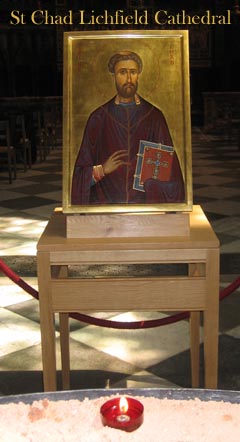
Litchfield Established AD 669
In the year AD 669, the year that the church in Lichfield, Staffordshire, UK was established, St Chad came to Lichfield to be its first bishop. His appointment as Bishop of Mercia was by King Wulfhere. Here he founded a monastery beside a well of spring water. The spring was where he baptized the converts and the church that he built was dedicated to St Mary.
The nature of St Chads appointment as a bishop gave rise to the more recent and unfortunate use of the word Chad to signify a false election result. From Mercia, Chad’s brother Cedd had gone to work first with the East Saxons before going north to Lastingham (in modern-day Yorkshire) where he had been given land for a monastery. On Cedd’s death from plague in 664, Chad succeeded his brother as Abbot of Lastingham and both brothers have a well there named after them.
The following year, Wilfrid, Abbot of Ripon, was sent to France to be consecrated as bishop of the Northumbrians. Wilfrid, however, lingered in France and Chad was summoned from Lastingham to be consecrated in his place. Bishop Wini of the West Saxons was the only bishop of the Roman tradition left in England, but, as three bishops were required for a consecration, two others still following the British traditions assisted.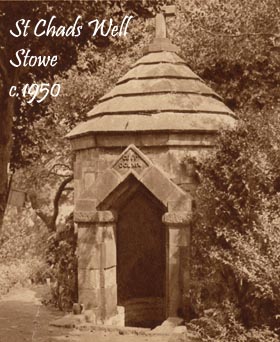
In 669, Theodore of Tarsus became Archbishop of Canterbury and immediately set about reforming the English church. On discovering two bishops in Northumbria, he declared Chad’s consecration invalid because of the participation of the two British bishops. Chad’s reply revealed his deep humility: “If you know I have not duly received episcopal ordination, I willingly resign the office, for I never thought myself worthy of it; but, though unworthy, in obedience submitted to undertake it.” Moved by this reply, Theodore completed Chad’s consecration according to Roman rites. However, Wilfrid remained as Bishop of York and so Chad returned to Lastingham.
This state of affairs did not last long, as later in the same year King Wulfhere of Mercia requested a bishop and Theodore sent Chad. Although there had been previous bishops working in Mercia, it was with Chad that the see was fixed at Lichfield and so Chad can be correctly described as the first Bishop of Lichfield.
The Stag Legend
The background to St Chad’s ministry in Lichfield is legendary. Wulfhere was the Christian king who had asked Theodore, the archbishop, to provide him with someone to be bishop in Mercia, and so Chad had come to Lichfield. According to this legend, Wulfhere later renounced his Christian faith at the persuasion of an evil counsellor called Werbode, and two of his sons, Wulfhad and Ruffin, were brought up as pagans.
While out hunting one day, son Wulfhad raised a stag which he followed to St Chad's cell at Lichfield, where it plunged into the spring there - now St Chad's Well - before fleeing into the forest again. On reaching the spring, Wulfhad saw Chad and asked him which way the stag had gone. Chad told him that he was to follow the stag no further. Its purpose had been to bring him here, to Chad's cell, so that he could be baptised in the Christian faith. Wulfhad challenged Chad, if his God was so great, to bring the stag back by prayer. Chad knelt and prayed, the stag returned and Wulfhad was baptised at the spring.
The next morning, Wulfhad returned home and told his brother all that had happened. Ruffin decided that he, too, would be baptised and the stag once more appeared, to lead them through the forest to Chad's cell.
Thereafter, the two brothers made frequent visits to Chad to be instructed in the Christian faith. However, the evil Werbode became suspicious and, after a successful spying mission, reported the brothers to their father, the king. In an uncontrollable rage, Wulfhere went to Chad's cell and demanded of his two sons that they renounced their new faith. When they refused, he slew them both. (Chad was saved, we are told, because on hearing their father approaching, the brothers had persuaded him to slip away.)
Later, realising what he had done, Wulfhere was overcome by guilt and fell ill. Eventually, he agreed to follow the advice of his wife and seek out Chad so that he could repent and be absolved of his sin. The stag made its third appearance, to lead Wulfhere to Chad. On arriving at the cell, Wulfhere could hear Chad saying Mass, and, conscious of his guilt, was reluctant to go in.
When Mass was finished, Chad hung his vestments on a convenient sunbeam (or so we are told) and came out to meet Wulfhere. As a penance for his sins, Wulfhere was instructed to replace paganism with Christianity throughout his kingdom, to found churches and monasteries, and to lead a Christian life.
Bede indicates that St Chad zealously devoted himself to all the laborious functions of his charge, visiting his diocese on foot, preaching the gospel, and seeking out the poorest and most abandoned persons in the meanest cottages and in the fields, that he might instruct them. When old age compelled him to retire, he settled with seven or eight monks near Lichfield. Tradition described him as greatly affected by storms; he called thunder 'the voice of God,' regarding it as designed to call men to repentance, and lower their self-sufficiency. On these occasions, he would go into the church, and continue in prayer until the storm had abated.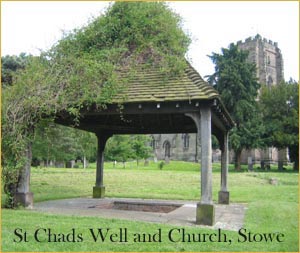
Stowe
There is some confusion as to whether the original church was on the site of the Lichfield Cathedral rather than a short walk away at nearby Stowe. It is likely that Chad’s church, dedicated to St. Mary, was somewhere on the site of the present cathedral and that the church nearby at Stowe was the site of the ‘house near the church, where he used to retire privately with seven or eight brethren in order to pray or study whenever his work and preaching permitted’.
St Chads church at Stowe is only about a half mile from Lichfield Cathedral. The present day church is a 12th century and later construction, the original Saxon one having been demolished. St Chads Well can be seen in the grounds of the present day church. It lies beneath a canopy erected in 1951, replacing an earlier enclosed stone built structure. Some say, St Chad was wont, naked, to stand in the water and pray, a habit that likely led to his saintly patronisation of cold bathing. Well Dressing here can be dated from the nineteenth century. This practice was revived in 1995.
Chad’s Death and his relicts
After two and a half years at Lichfield, there came a time of plague which ‘freed many members of the reverend bishop’s church from the burden of the flesh’. It is related that seven days before his death, a monk named Arvinus, who was outside the building in which he lay, heard a sound as of heavenly music attendant upon a company of angels, who visited the saint to forewarn him of his end. St Chad died in 672 and his body was buried near the church of St Mary’s. In 700 his bones were relocated to the newly completed cathedral in Lichfield. His remains were enclosed in a rich shrine, which, being resorted to by multitudes of pilgrims, caused the gradual rise of the city of Lichfield from a small village. It is related that the saint's tomb had a hole in it, through which the pilgrims used to take out portions of the dust, which, mixed with holy water, they gave to men and animals to drink.
Chad's cult was destroyed at the Reformation and his relics were scattered, apparently in 1538. A prebendary of Lichfield, Arthur Dudley (a relative of the Sutton Lords Dudley and of the cadet branch of the Dudley family who held various high offices and titles in 16th C), scooped up a few of Chad's bones. He is said, in a document written by a Jesuit priest in mid 17th C, to have deposited them with two sisters, members of his family, in Russells Hall, Dudley. The sisters eventually entrusted the few bones to Henry and William Hodgetts, recusants of Woodsetton in the neighbouring parish of Sedgley. William died first (he apparently 'divined' thefts with a crystal ball, among other things). Just before Henry died, in 1651 (not 1615, as the local version has it, from an early 19th C published translation of the Latin), he gave the relics to the Jesuit priest who administered the Last Rites. The fragments were given by the Jesuit to a member of the Leveson family, royalists and recusants, at least one of whom was involved in defending Dudley Castle around that time. A Puritan raid on a Leveson house resulted in the loss of some of the bones. The rest were hidden by other Staffordshire recusant families until religious toleration acts were passed at the end of 18th C and beginning of 19th, and the Cathedral for the RC Archdiocese of Birmingham was the obvious destination for them. (supplied by Buckley C from Greenslade 1996 & 2006)
St Chad remains and are now in the hands of the Birmingham Roman Catholic Cathedral. Carbon dating has confirmed that the remains are contemporary with the life of St Chad.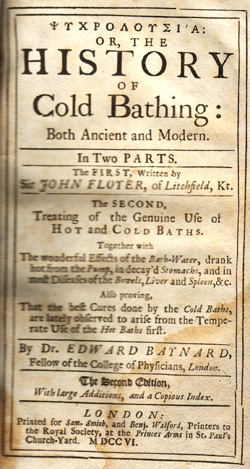
Celebration of St Chad and cold bathing
Sir John Floyer of Lichfield, the celebrated physician to Charles II, in 1706 published a curious collection of letters about the medicinal values of cold bathing. In his text he describes St Chad as one of the first converters of our nation, who used immersion in the baptism of the Saxons; such immersion being beneficial to the body as well as the soul. Floyer concludes that the well near Stowe, which bears Chad's name, was his baptistery, it being deep enough for immersion, and conveniently seated near the church; and that it has the reputation of curing sore eyes, scabs, &c. Sir John Floyer, it should be added, set up his own baths at Unite’s Well. This lay about one mile north-west of Lichfield. He appropriately named his baths after St Chad, the water of which he observes to be the coldest in the neighbourhood. Sir John gives a table of diseases for which St Chads Baths was efficacious (Floyer J. 1706, p.17 - 27.).
Chamber’s “Book of Days” indicates that Chad was designated "Patron Saint of Medicinal Springs" as a result of the miraculous healing achieved using the dust from his shrine mixed with Holy Water. An alternative view, expressed by Sunderland (1915) is that the designation resulted from his practice of bathing naked in his well at Stowe, by the church.
Today’s archaeology
The cult of St Chad has resulted in the name being adopted in up to 42 instances of springs and wells and one may conclude that the patron saint of medicinal springs was a very powerful endorsement of a well’s properties. This may not be as clear cut as first assumed however. St Chad’s wells in some instances are likely a transformation or hagiologising from “cealdwiella” or cold well. (Harte p.8) Chadwell in Essex for example in 1578 was Chawdwell but by the 20th century had adopted the nomenclature St Chad's Well. It is not surprising that Floyer therefore took an interest in the well at Lichfield in view of his interest in cold bathing as a cure. It would appear that St Chad became synonymous with cold wells.
Today we find St Chad's name being used to name hospitals, doctor's surgeries and health centres. The cult lives on. Meanwhile the St Chads Foundation Trust strives to protect and enhance the site of St Chad’s Church and Spring at Stowe, near Lichfield.
St Chads Feast Day is March 2nd.
B E Osborne 2009 
General and detailed sources:
Pictures by S Arnold and B Osborne;
Anglo-Saxon Chronicles Ingram J (1912 reprint 1929). p.40.
Book of Days Chambers R (1864) p.321.
Catholic Staffordshire Greenslade M (2006) Gracewing Books, Leominster
The Forgotten Cathedral Current Archaeology 205 (2006) Rodwell W, p.9-17.
English Holy Wells – a sourcebook Harte J (2008) Heart of Albion Loughborough. Vols 2 and 3 are the gazetteer.
History of Cold Bathing – both ancient and modern Floyer J (1706) Walford London.
London’s Spas, Baths and Wells Sunderland S (1915) Bale, London. p.13-16.
On Eagles Wings The Life and Spirit of St Chad Adam D (1999) Triangle London.
Saint Chad of Lichfield and Birmingham Greenslade M W, (Archdiocese of Birmingham Historical Commission, publication number 10, 1996)
The Living Stream – Holy Wells in Historical Context Rattue J (1995) Boydell Woodbridge
Other sources include www.stchads.org.uk together with the archives of the Spas Research Fellowship. James Rattue and Jeremy Harte have both aided the preparation of this paper.
Number 6. Health and Wellness Tourism - past, present and future.
Based on a presentation at World Travel Market November 2006 by Dr Bruce Osborne
For the individual, health and wellness has always been high on the agenda. Since time immemorial humankind has sought to maintain good health as an integral part of a survival strategy. This has manifested itself in a variety of ways from bathing in hot springs to practitioners of magical and mystical treatments. Some of these practices were spurious, often due to the lack of medical knowledge; others were effective for unknown reasons. Let us trace some of the milestones in the evolution of the health and wellness industry.
The word spa became a generic term for a health resort in the 17th century. We can however trace the origins of the health and wellness industry which has traditionally been associated with natural water based therapies. 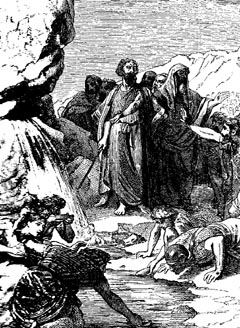 The earliest reference to magical healing waters that we have researched dates to about 1700 BC. (Gen 36:24 New English Ed.) In Genesis in the Bible new edition, it is recorded that Anah, one of the sons of Zibeon discovered hot springs in the wilderness as he pastured the donkeys of his father. This was in the region of Mount Seir in what is now the Shara Range in Southern Jordan, near the ancient town of Petra. Scholars believe that this was the Mount Sinai, where God dwelt in the Old Testament. Anah and his family were members of the tribe of the descendants of Esau, which had relocated from Canaan. A little later Moses struck the rock with his staff in the vicinity and twelve springs gushed forth.
The earliest reference to magical healing waters that we have researched dates to about 1700 BC. (Gen 36:24 New English Ed.) In Genesis in the Bible new edition, it is recorded that Anah, one of the sons of Zibeon discovered hot springs in the wilderness as he pastured the donkeys of his father. This was in the region of Mount Seir in what is now the Shara Range in Southern Jordan, near the ancient town of Petra. Scholars believe that this was the Mount Sinai, where God dwelt in the Old Testament. Anah and his family were members of the tribe of the descendants of Esau, which had relocated from Canaan. A little later Moses struck the rock with his staff in the vicinity and twelve springs gushed forth.
The Romans built bath houses throughout their empire. The Thermal Baths of Classical Rome are without doubt one of the Seven Wonders of the Spa World. Even what remains today is awe inspiring. In 33 BC there were 170 baths in Rome according to Agrippa's census. Baths were a popular public facility for Emperors to provide as was demonstrated by Nero and Trajan, however it was in 212 AD that the building of the Baths of Caracalla was commenced, the most sumptuous and grandiose baths ever built, to be followed in the year 292 AD with the Baths of Diocletian, the largest baths complex ever. The Baths of Caracalla were in use for three centuries before they lost their aqueduct water supply in the siege of Rome 537 AD. The baths could accommodate between 6,000 and 8,000 bathers a day. In spite of centuries of abandonment and plundering, the surviving site is virtually intact. Located to the south of the city of Rome, the ruins today tower some 30 metres above ground across the 11 hectare site, which includes extensive underground levels for service ducts etc. The equivalent of 9,000 workers were employed for a period of 5 years to create this masterpiece, both in size and magnificence. Lavish decoration included floors of marble and mosaics, hundreds of statues and embellishments of walls and ceilings that elevated the baths to the status of the grandest of palaces. They were visited by all social levels and were the meeting place for the populace of both sexes.
The Baths of Caracalla were in use for three centuries before they lost their aqueduct water supply in the siege of Rome 537 AD. The baths could accommodate between 6,000 and 8,000 bathers a day. In spite of centuries of abandonment and plundering, the surviving site is virtually intact. Located to the south of the city of Rome, the ruins today tower some 30 metres above ground across the 11 hectare site, which includes extensive underground levels for service ducts etc. The equivalent of 9,000 workers were employed for a period of 5 years to create this masterpiece, both in size and magnificence. Lavish decoration included floors of marble and mosaics, hundreds of statues and embellishments of walls and ceilings that elevated the baths to the status of the grandest of palaces. They were visited by all social levels and were the meeting place for the populace of both sexes.
The Baths of Diocletian have not survived so well in many respects. Although now preserved, much of the ruins, which lie nearer the centre of Rome, have been lost due to road schemes and general plundering over the centuries. The site occupied over 13 hectares in its original form. The water came from the Aqua Marcia and travelled some 91 km from the source springs; it remains one of the most important sources for present day Rome. A fortuitous restoration occurred in the 16th century when Michelangelo was commissioned to restore part of the baths as a church. The works took 200 years to complete, conserving many of the original features in the central area to produce The Basilica of Saint Mary of the Angels and the Martyrs, an edifice of huge proportions, albeit only occupying part of the original baths building. This restoration provides a unique opportunity to appreciate the size and elaborate decoration of the original baths. Part of the remaining structure of the baths is now occupied by the State Museum.
But why did the Romans need such magnificent bathing facilities? Can the need for a daily 3 hour plunge be explained in modern scientific terms?
The reason Romans were wedded to the idea of bathing can now be revealed with the benefits of modern day research into weightlessness. If you remain submerged in water for a prolonged period you expel heavy metals. Romans suffered from lead poisoning – they fortified their wines with lead salts and ate from pewter utensils. Successful Romans used the baths regularly and felt better as a result.
Ancient Britain after the Romans - As the Roman Empire crumbled, religion became the guiding light of nations and religion quickly took on board both spiritual and bodily health.
St Chad is regarded as the missionary who introduced Christianity to the East Saxons. He was educated at the monastery of Lindisfarne, or Holy Island, of which he became the bishop. Upon his canonization, St Chad became the patron saint of medicinal springs. St Chad died in 672 and his body was buried near the church of St Mary’s, Lichfield.
Sir John Floyer of Lichfield, the celebrated physician to Charles II, in 1706 published a curious collection of letters about the medicinal values of cold bathing. In his text he describes St Chad as one of the first converters of our nation, who used immersion in the baptism of the Saxons; such immersion being beneficial to the body as well as the soul. Floyer concludes that the well near Stowe, which bears Chad's name, was his baptistery, it being deep enough for immersion, and conveniently seated near the church; and that it has the reputation of curing sore eyes, scabs, &c. Sir John Floyer, it should be added, set up his own baths at Unite’s Well. This lay about one mile north-west of Lichfield. He appropriately named his baths after St Chad, the water of which he observes to be the coldest in the neighbourhood. Sir John gives a table of diseases for which St Chads Baths was efficacious. (see Floyer J. History of Cold Bathing, 1706, p.17 - 27.)
The importance of water to health has similarly been reflected in other ancient cultures.
This merging of spiritual and bodily health perpetuated through the middle ages, with the cult of saints and ritual baptism in natural waters as exampled by the cult of St Werstan.
Holy Wells and Healing Springs, the focus for pre-Roman belief systems were often these were taken over by the religious establishments and given in modern parlance a brand image relaunch by the church, who incorporated the taking of the waters in the church doctrines and rituals.
For example St Werstan or Werstern was a legendary monk who relocated to Malvern from the monastery at Deerhurst in the time of Edward the Confessor. Encouraged by the presence of pure spring water, Werstan chose a rocky ledge in the vicinity of the present day St Ann’s Well to found his hermitage. The spring may well have been named after him, St Werstan's Well, with St Ann's Well a much later designation. Here Werstan hoped to live a holy and solitary life as a recluse but was murdered and subsequently honoured as a martyr saint. The hermitage was established here before the Norman Conquest and was eventually to lead to the creation of a full scale priory. Thus Malvern Spa was founded.
Other religious cultures similarly incorporated everything from baptism by water to ritual bathing within their traditions. This encompassed everything from the hammans of the Muslim world to the sauna tepees of the Native Americans.
As time progressed the religious involvement was superseded by a more commercial approach and throughout the world we see spas as specific resorts being established from the 15th century onwards. This coincided with the formalising of the medical expertise and the certification of who was qualified to legitimately practice medicine. This had the effect of building confidence in the medical profession and separating out some of the more suspicious and doubtfully effective therapies and practitioners. By the end of the 18th century Andrews Map dated 1797 listed 215 resorts in Great Britain alone. The tradition of water based therapies for spas perpetuated and the great 19th century world spas all had a range of services based on taking the waters, some cold, come warm or hot, depending on the availability of thermal waters.
Today we continue to build on this rich heritage with our modern day flourishing spa industry. At the same time it is comforting to echo the roots of our industry. We find the legendary St Chad's name being used to name hospitals, doctor's surgeries and health centres. St Werstan is considered the patron saint of Malvern Springs and Wells. The tradition lives on.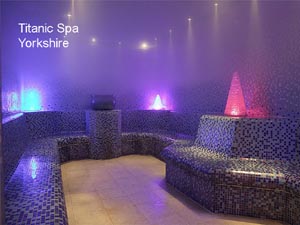 The modern spa industry that we know today really took off at the end of the 20th century in the UK, USA and many British Commonwealth Countries. In other countries such as Germany and France the tradition continued to flourish unabated from former times however. By 2000 we saw the demise of the health farm to be replaced by the destination spa.
The modern spa industry that we know today really took off at the end of the 20th century in the UK, USA and many British Commonwealth Countries. In other countries such as Germany and France the tradition continued to flourish unabated from former times however. By 2000 we saw the demise of the health farm to be replaced by the destination spa.
But what forces in society have powered this recent change?
1. Greater awareness and responsibility for personal health and well being. Also prevention rather than cure culture.
2. Increased disposable wealth
3. Explosion in travel, both by road and now in the air.
4. Enhanced knowledge about health and facilities available particularly though Information Technology, especially the World Wide Web.
5. Growing suspicion and costs associated with orthodox medicine.
6. More leisure time, which individuals wish to use in a constructive manner.
7. Emphasis on healthy living in all walks of life – food, environment and home.
8. Spas and health resorts are no longer the retreats for the wealthy and elite.
And what are the outward signs of this evolution in health care? This change can be recognised through the emergence of numerous monthly and bi-monthly publications world wide both for the trade and the consumer. A wide range of branded products for use in spas has also emerged. Also there are now numerous travel operators specialising in spa breaks. Associations and representative bodies are emerging world wide. The British International Spa Association was founded in 1998 and now promotes an education scheme as well as its world wide acclaimed spa accreditation scheme, now moving into its third generation of development.
Spa now provides a significant layer of health care that underpins mainstream medicine. This is based on prevention as much as cure to provide lifelong well being.
Since 2000 world spas have grown at an exponential manner. We now have a $40 billion dollar global market (Spa Finder).
In the UK the industry is quoted as being worth £1.4 billion p.a. with 20 spas opening each week. (Times 29 April)
The Spagazers.com Spas Directory targeted 5000 spas world wide in 2002, now we target 8000 major establishments and a growth rate of about 10 percent per annum compound appears to relentlessly prevail. This raises the question what is a spa? We continually monitor what the consumer perceives as a spa as the basis for the ongoing definition that inevitably changes over time.
Spa have identified that just under 60 percent of North American adults have visited a spa in the last year, over a half of them visiting while travelling. Half of these visits were spontaneous and unplanned.
At the moment the market is principally split between the local user and the spa tourist. In future however we will see the expansion of new types and applications for spas in one form or another.
What are the issues of change that we need to address? Where are we all going?
I now suggest an 11 point prognosis for the future.
1. More litigation and legislation as consumers have paid for a service and have an expectation to be realised. Being “spa wise” they will know what they want and expect value for money. Mystique will no longer be a curtain for spas to hide behind. Research has shown that people are concerned about firstly quality of treatment, then cost, then hygiene, then benefits of treatment and then qualifications of therapists.
2. The expansion of the middle ground between orthodox medical and pampering – more pseudo and near medical treatments, especially involving appearance and longevity. Obesity is a typical problem that spas can usefully address; not only diet and exercise but also cosmetic surgery to remove some of the less attractive aspects of weight loss.
3. Introduction of more social ethos into spas. Visiting a spa should not be a lonely experience. Enjoyment is an essential part of feeling good and wellbeing. Who wants to spend an hour on a cycling machine and then go home having not passed the time of day with anyone?
4. New ways of delivering a service. Mobile spas have dramatically expanded in the US in the last year with the advantages of low overheads and parties etc. making it more of a social event. Cruise ship spas are now essential for that type of holiday. How about spa treatments while you fly long haul? How about spas for the elderly or children, extending the role of rest homes and retirement parks or children’s specialist day care centres? Taking it one stage further how about pet spas, we already have horse spas?
5. More spa lifestyle in the home and environment, there is little point in going to a spa to relax and then within minutes picking up the kids and getting into a traumatic traffic situation, undoing the investment made earlier. Turn that spare room into your own mini spa or therapy room and import your therapist. Swimming pools and saunas have been around in homes for years and more recently hot tubs. How about a fully fledged bath house, Roman style with its various hot and cold rooms and plunge pools?
6. Expansion of specialised and niche product treatments, for example the development of water based cures based on mineralization of unique local water sources. There will be a great move into traditional water based treatments tested over time for specific ailments such as rheumatism, as part of this specialisation. Sound Therapy, Sensory Deprivation and other pioneering therapies will continually emerge and some will survive the test of time.
7. There will be corporate consolidation of more powerful operators giving a distinct marketing barrier for new entrants at the top end. Alongside this the small businesses will continue to expand in numbers providing a distinct personalised local service. This will create greater market segmentation.
8. Fitness clubs will respond to the need for a social environment by incorporating dance and other fun, energetic activities for all age groups. Also we will see an expansion of drop in facilities rather than long term membership programs which notoriously decay after the first two years.
9. There will be a general expansion of the media alongside that of the industry – web based information sites, journals, informative books, CDs for home instruction, chat rooms on line, and how about spa friends on line? Ninety percent of North American spa travellers plan using a web site.
10. We will see ever increased corporate investment based on added value to an existing enterprise, last seen in the expansion of the worldwide golf industry. Now corporations are attracted to the added commercial potential of spas, with the potential to enjoy income from more opportunities to charge for services, annexed to existing commercial infrastructures. As a means of generating income through private finance, how about spa timeshare and joint ownership deals to produce venture capital? For those who have visited Los Vegas, how long will it be before we see a pleasure dome of spa as one of the newest attractions, alongside the recreation of Egypt with the Luxor and recreated canals and Bridge of Sighs at the Venetian?
11. Finally there will be more franchising of a spa facility to a specialist operator with the development of stronger branding for the spa itself rather than the products that it uses. Who will be the MacDonald’s of spa with international high street branding comparable to Coca Cola?
Superimposed on all this will be more general concerns and trends, for example the implications of global warming and environmental issues such as water shortage and the recycling water.
To conclude, how does an organisation like the Spas Research Fellowship cope with these market dynamics in a manner that continues to provide a meaningful service to the industry?
The Spas Research Fellowship is a non-profit making Fellowship that promotes education, research and scholarship into all aspects of spas and health resorts and the use of mineral and spa waters. Established in the year 2000 Spagazers.com is the SRF web based directory of spas and health resorts. Spagazers.com is the leading international web search facility for those wishing to find out about spas. In addition there are a range of other spagazer services.
Spagazers.com is the modern day oracle of the spa industry. It is a sophisticated search engine programme that is infinitely variable in its ability to list and identify the characteristics of spas. This includes not only therapies available but also other facilities such as golf or cycling. By continuously monitoring and amending the search criteria the SRF can keep abreast of new therapies and marketing initiatives from the industry and individual spas. In this way the consumer is using a web search facility that is relevant to the very latest spa marketing proposition. For example the Pick and Tick search facility now lists everything from ethnicity to climatic characteristics and much more as well as the regular therapies, treatments and geographical location on offer. The result is the ability to search for a spa that meets the particular consumer criteria. Spagazers.com also identifies BISA Accredited Spas and has a Plan a Trip facility linked to leading spa travel operators. As a result spagazers is a potent marketing tool for a resort to capitalise on by securing a listing because it is searched by individuals seeking specific faculties which can then be identified and pursued.
But will this offer a trouble free route forward? No, there are significant threats to the spa industry and BISA Accreditation at www.bisawaves.com is just one way of dealing with a possible failure of consumer confidence and other threats to success.
Bruce Osborne
Number 7. History of the British Spas Federation
This paper has been updated in 2013. The updated version can be viewed by clicking on the panel below.
Known guides from the BSF with publication dates
BSF Handbook and Guide (1916) – no known copy (see note to 1921).
British Spas & Health Resorts (1920) 2nd ed. Burrow, Cheltenham. – paper back, SRF have copy.
British Spas & Health Resorts (1921) 3rd ed. Burrow, Cheltenham. – paper back, copy in BL (note – page 13, F Broome says: “1916, BSF as a concrete body published its first handbook”).
The Spas of Great Britain (c.1924) Official handbook of the BSF, Pitman, Bath. – red hardback, SRF has copy.
The Spas of Great Britain (c.1930) Official handbook of the BSF, Pitman, Bath. – blue hardback, SRF has copy.
In addition there are the handbooks of the British Health Resorts Association (founded 1931). These appear to be annual publications with a break for World War II.
British Health Resorts (1934) 2nd edition – grey green paperback, SRF has copy.
British Health Resorts (1938) 6th edition – grey green paperback, SRF has copy.
British Health Resorts (1939) 7th enlarged edition – grey green paperback, BB has copy.
British Health Resorts (1950) 8th edition – yellow paperback, SRF has copy.
We would welcome information on any of the missing guides.
The above paper is copyright and any use made of the information contained therein must have the source and author acknowledged. Extracts may only be reproduced with written permission.
Dr Bruce Osborne. Spas Research Fellowship
Number 8. Spa Souvenirs
The clutter that we collect from the past provides an interesting insight into the psychology of tourism. Humankind is unique in amassing such artefacts and they provide a variety of cognitive delights. Travel souvenirs enable us to recall times past, the tangible memory trigger to otherwise forgotten good times. Heritage souvenirs provide us with evidence of the past, especially the sense of wonderment precipitated by the unexplained artefact. More sinister is the accumulator souvenir, which demonstrates the trait of owning something that others do not – thereby somehow elevating the collector’s status, especially when a monetary value is involved.
To understand spa souvenirs is to understand the water cure. In the endless pursuit of immortality or at least longevity, the water cure has had many attractions. One was certainly that a water cure was potentially less damaging than the measures applied by orthodox medicine. From the earliest times to quite recently, a sojourn at a spa was totally different to the consultation with one’s physician or worse, one’s surgeon. The water cure represented a more holistic approach to healing, whether it was in the UK or abroad, more often than not in Continental Europe. Bathing and massages were certainly ways of making the patient feel better and drinking the water at worst caused purging, and that was usually no bad thing. Not only did taking the cure involve water however; the spa location was often in pleasant countryside and if a town, there would be parks and gardens in which to promenade and socialise. Then there was the entertainment. The Theatre and the Assembly Rooms provided a constant stream of events that often involved dancing, combining fun with exercise. Sports were laid on, often with the small wager being placed on a likely winner. The spas were no strangers to horse racing and in fact the sport developed alongside the other infrastructure of the spa. Gambling and the Casino provided entertainment for those of like mind.
Those who could afford it flocked to the spas, often for several weeks at a time, to recover from ailments described as Melancholy, Distempers and the King’s Evil as well as terms that we are familiar with today. This caused a social hierarchy to emerge at the spas and between rival resorts. At their zenith, Bath and Tunbridge Wells were typical of those patronised by the elite. This in turn cultivated a social scene that only the unambitious or the poor could afford to ignore. Less publicised were the sexual goings on. With such a social intercourse it is little wonder that many saw the opportunity of a modest debauch. The result was that spas became a place to enjoy oneself, all in the interests of good health. In fact doctors recommended the enjoyment as a remedy. With hindsight it is possible to conclude that a combination of genuine benefits from the mineral waters, a regime that encouraged the body’s natural healing to function and feeling good as a result of having a good time, all combined to make the spa resort worthy of patronage.
No wonder visitors returning home from the spas cherished souvenirs as tangible testimonials of those memorable experiences. Commerce prospered and like the seaside towns that flourished in the 19th and 20th centuries, the spa resorts spawned a souvenir trade. For many, a visit might involve a relatively short period in the day for actual treatment or taking the waters. 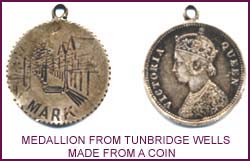 The rest of the day was spent at leisure or suitable mind developing pursuits. Charles Darwin developed his thesis on origins of the species at Moor Park Spa near Farnham. Others wrote less serious works often intended to amuse and record the season at a particular establishment. Many visitors explored the surrounding countryside and guidebooks became the inevitable souvenir and record of what had been discovered. The first mass produced guidebooks appeared in the 1780s with all the major Spa towns sporting their writings on the local topography and history. Writers such as Daniel Defoe had published more general accounts of tours through Great Britain in the early 18th century. Directories on the qualities and healing uses of the waters had also appeared much earlier. Dr Rutty published A Methodical Synopsis of Mineral Waters in 1757, following Dr Short’s History of Mineral Waters in 1734. Both tomes contain assessments of various water’s properties, efficacy and topography. A plethora of Doctors thereafter replicated and expanded on the qualities of mineral waters, with every spa seeking a Doctor’s published endorsement. Many personal accounts of the visit to take the waters had been the subject of individual’s diaries, these becoming a private keepsake, and it was not until modern times that these were published. Celia Fiennes toured the spas in the late 17th century and her diaries were first fully published in 1947. Thereafter emerged a major industry in tourist guides, technical manuals and satirical outpourings associated with the spas and those that visited and explored them. These are now important reference works as well as heritage souvenirs, particularly those of such people as Dr Granville, who recorded his visits to German and British Spas in a series of volumes around 1840.
The rest of the day was spent at leisure or suitable mind developing pursuits. Charles Darwin developed his thesis on origins of the species at Moor Park Spa near Farnham. Others wrote less serious works often intended to amuse and record the season at a particular establishment. Many visitors explored the surrounding countryside and guidebooks became the inevitable souvenir and record of what had been discovered. The first mass produced guidebooks appeared in the 1780s with all the major Spa towns sporting their writings on the local topography and history. Writers such as Daniel Defoe had published more general accounts of tours through Great Britain in the early 18th century. Directories on the qualities and healing uses of the waters had also appeared much earlier. Dr Rutty published A Methodical Synopsis of Mineral Waters in 1757, following Dr Short’s History of Mineral Waters in 1734. Both tomes contain assessments of various water’s properties, efficacy and topography. A plethora of Doctors thereafter replicated and expanded on the qualities of mineral waters, with every spa seeking a Doctor’s published endorsement. Many personal accounts of the visit to take the waters had been the subject of individual’s diaries, these becoming a private keepsake, and it was not until modern times that these were published. Celia Fiennes toured the spas in the late 17th century and her diaries were first fully published in 1947. Thereafter emerged a major industry in tourist guides, technical manuals and satirical outpourings associated with the spas and those that visited and explored them. These are now important reference works as well as heritage souvenirs, particularly those of such people as Dr Granville, who recorded his visits to German and British Spas in a series of volumes around 1840.
Going to a spa was a serious business for many and the focus was the taking of the waters, often as a “medicine” with a prescribed dose each day. Such serious activities necessitated the provision of specialist equipment. Early artefacts include pilgrim souvenirs. Late Roman and Byzantine pilgrims fostered the notion that the sanctity of the Holy Well was somehow transferred to an inanimate souvenir or relic, to be taken home. Later flasks and badges became the symbol of a visit to a religious spa. As a result of both Holy and secular cures, not only did the fountain head develop into a splendid decorative celebration of the healing liquid but so also did that from which it was imbibed – the drinking glass. This culminated in the most splendid glasses of all time. Bohemian crystal glasses, delicately cut, in a variety of colours graced the lips of the wealthy, suggesting a display of visible wealth as well as a practical drinking vessel. Such glasses emerged particularly from the continental spas during the 1860s but were also customised to the UK spas about this time. For the less fortunate a wide variety of cups and jugs of many shapes and sizes provided the owner with a permanent momento of those days spent queuing at the appropriate spring. 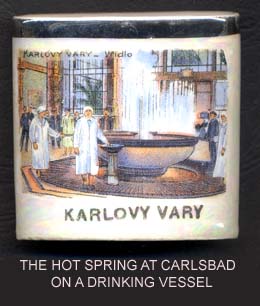 Some included measuring lines to gauge the amount of the efficacious liquor to be consumed. Many bore the name and possibly a picture of the particular resort. Oval glasses were designed for slipping into the pocket to ease the problem of carrying them about. Modern French and German spa resorts still sell glasses in the traditional basketwork carrying panniers, although recently plastic versions have been introduced.
Some included measuring lines to gauge the amount of the efficacious liquor to be consumed. Many bore the name and possibly a picture of the particular resort. Oval glasses were designed for slipping into the pocket to ease the problem of carrying them about. Modern French and German spa resorts still sell glasses in the traditional basketwork carrying panniers, although recently plastic versions have been introduced.
An interesting variant on the drinking glass was the “pohary”. This was a feature of the Czech spas such as Marianbad and Carlsbad. These strange containers resemble a small teapot with spout and handle but no lid. The waters are sipped through the spout. The spout enabled the drinkers to take the waters without contact with the teeth, which may be discoloured. Its use continues to this day. Not all patients were on secular visits to spas however. Holy Well, in North Wales and other shrines provided waters that relied on divine intervention rather than mineral content to do their work in healing. For the religious pilgrim the momento was often a small bottle of the sacred waters or even a religious icon or adornment.
The drinking of unpleasant tasting waters gave rise to another product range. This was a food product produced to ease the imbibing of the water. In Bath Dr Oliver’s Water Biscuits became famous and can still be purchased, albeit having lost their provenance as an aid to taking the cure. The Kolonada Luxus wafer is still manufactured in the spas of the Czech Republic. And for those who wish to avoid taking the waters internally, Harrogate soap still offers the sulphur experience without the taste. Or for those who want to handle the minerals, Saltzburg natural rock salt can be found in a variety of coloured cubes neatly packaged to take home. These items all provide either tantalising presents for friends or personal reminders of the spa.
For those unwilling or unable to regularly visit their spa resort, enterprise in the form of water bottling came to the rescue. From the 17th century onwards, bottled water was distributed not only as refreshment but also as a health tonic, often for dietary purposes to be taken with a meal. In the 19th century glass superseded the clay bottle although Apollinaris water was still available in the early 20th century in the traditional Krug (German) or cruches (French). In 1784 Selters in Germany was exporting more than a million clay bottles of Seltzer water, a figure which doubled by 1834. Today these clay bottles can be easily found and they contain a variety of impress marks testifying to the efficacy and origins of the water within. These gave rise to the German expression “Der Krug geht so lange zum Brunnen bis er bricht” or “The pitcher goes to the well until it gets broken” meaning: you’ll do that once too often. Glass bottles and syphons, often with illustrations, because of their robustness, provide collectable heritage souvenirs of spas and spa waters.
The advent of photography after 1860 gave rise to the development of another souvenir industry – the postcard. Before this small prints were sold, produced by a range of techniques. These were often purchased singly to illustrate a personal diary or available in books of views. With the advent of the postcard, not only did the spa visitor retain mementoes of his visit, he also imposed them on his friends and relatives. Aided by a more effective postal system, the post card quickly became popular in the late 19th century, recording a visit in the message on the back, and for some, incorporating a personal photograph on the front. At the Glanne Wells at Builth it was a regular practice to photograph the groups of spa visitors and reproduce the group shot as a postcard to send to those back home in “The Valleys”. Alongside the serious subjects of postcards, particularly topographical, came the more humorous side. Many active spas continue to produce ranges of humorous cards as did Harrogate and other UK resorts in their days as active spas.
Some spas became famous for their particular tourist souvenirs. Tunbridge Ware was popular throughout the history of Tunbridge Wells, culminating in an intricate art form reflecting the craftsman’s ever developing skills. Similar wooden ware was also available from the town of Spa in the Ardennes. Printed scenes and wording depicting the spa resort was added to small wooden containers and this spawned another range of souvenirs. These depictions are now often important records of the visual landscape of the time.
Another souvenir of a spa visit was particularly pertinent to Bristol, as procured by Celia Fiennes in 1698. The spa was located in the Avon Gorge about two miles from the city centre. Visiting the Hotwells, as the area was known, was only one of the pastimes, the other was searching for Bristol diamonds. 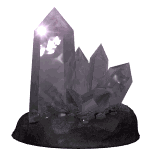 Although not as hard as real diamonds, the Bristol diamond was made into jewellery. There are several schools of thought on the identity of the Bristol diamonds, lapis calaminaris, that Miss Fiennes searched for in small crevices in the rock of the Avon Gorge. Some were clear, colourless and brilliant and were of sufficient quality to make into jewellery. They were hard enough to cut glass and some, tinged with yellow and purple, were called Bristol topazes and amethysts. A local industry grew up supplying the demand for Bristol diamonds to visitors but shops were reputed to be selling "spar crystals" rather than the genuine specimens. In 1634 three worthy gentlemen visited Bristol as part of a survey of 26 counties. They inspected the strange hot well that gushed from the rocks when the tide was out, finding that people washed in and drank the medicinal waters. Having seen the wells they retraced their path up the 200 slippery steps seeking on the way the "glittering bastard diamond stones". The State Papers of James I mention that Bristol diamonds were used to decorate the King's palace, Theobalds. The Hot Wells and diamonds gave rise to a romantic novel set in the year 1773, Bristol Diamonds published in 1897, in which a locket of the mineral features prominently in the plot. The author, Emma Marshall also includes interesting descriptions of social life at the spa.
Although not as hard as real diamonds, the Bristol diamond was made into jewellery. There are several schools of thought on the identity of the Bristol diamonds, lapis calaminaris, that Miss Fiennes searched for in small crevices in the rock of the Avon Gorge. Some were clear, colourless and brilliant and were of sufficient quality to make into jewellery. They were hard enough to cut glass and some, tinged with yellow and purple, were called Bristol topazes and amethysts. A local industry grew up supplying the demand for Bristol diamonds to visitors but shops were reputed to be selling "spar crystals" rather than the genuine specimens. In 1634 three worthy gentlemen visited Bristol as part of a survey of 26 counties. They inspected the strange hot well that gushed from the rocks when the tide was out, finding that people washed in and drank the medicinal waters. Having seen the wells they retraced their path up the 200 slippery steps seeking on the way the "glittering bastard diamond stones". The State Papers of James I mention that Bristol diamonds were used to decorate the King's palace, Theobalds. The Hot Wells and diamonds gave rise to a romantic novel set in the year 1773, Bristol Diamonds published in 1897, in which a locket of the mineral features prominently in the plot. The author, Emma Marshall also includes interesting descriptions of social life at the spa.
As UK spas progressed into the 20th century, spa souvenirs took on a distinct similarity to those of other tourist resorts and commercial advertising aids. Paperweights advertised the natural aperient waters of Apenta while bottle top removers promoted Perrier. In particular the collection of armorial china resulted in numerous items being produced representing such diverse subjects as St Ann’s Well at Malvern to Mr Pussyfoot, the prohibitionist standing by the water pump. A variant on this theme was the pictorial china, popular with the resort visitors everywhere. This often depicted a scene.
Inevitably, especially in the UK spas, emphasis is now on spa heritage and souvenirs of past glory have replaced souvenirs reflecting usage of the waters. In Bath you have been able to purchase a piece of Roman ruin from the site of the new spa in the city centre. Posters are popular from many European resorts, particularly the stylish creations of the late Victorian and Edwardian periods, now alas reproductions. The Cwm Dale Spring at Church Stretton is available on a model van livery. The variety is of course endless. Towelling and sports apparel, customised to the resort, is available from many continental spas. In addition we now find a vast range of spa related beauty and therapy products ranging from “Hot Springs” natural mineral bath salts to Trefriw Wells iron tonic waters. For many serious collectors however the desire is not to secure the mass-produced souvenir but to discover a spa artefact that carries historical associations, such as a treatment time hourglass from Droitwich Brine Baths or the original diaries of a spa visitor. At the time these were considered worthless or of no interest by descendants faced with the problems of house clearance. Time has however given these artefacts an importance that turns them into treasures. Such items are hard to find.
Further reading:
Evans G (1999) Souvenirs, from Roman Times to the Present Day, NMS Pubs. Royal Museum, Edinburgh.
Dr Bruce Osborne.
Spas Research Fellowship
Back to the page contents list